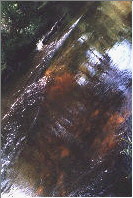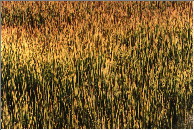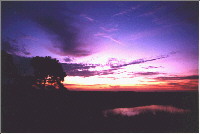

In the Land of the Great Swamps
The great swamps of Florida's Big Bend lie in an area roughly
bounded on the north by Cody
Scarp, on the east by the Aucilla River, on the south by
Apalachee Bay, and on the west by the Wakulla River.
Much of the area is known by this name, pronounced
wah-kull-ah,
which means in the language of its prior
inhabitants, "The Mysterious".
The underlying ground is limestone, the rock made by life.
Born as seafloor,
since sometimes coastline, sometimes upland, sometimes seafloor again,
at our moment in geologic time it sits a scant few
feet above sea level. Large limestone and flint
boulders are scattered about in some
places with no apparent purpose or origin.
Where the soft rock is exposed in a river bank,
water has sculpted fantastic gargoyle-like figures.
In one place, a line of low hillocks stretches more
than a mile across the swamp. Viewed from above, they resemble
nothing so much as the bones of some felled Goliath, or a series
of miniature volcanic cones.
Nearby is an ancient dune, with sand and flint as white as the clouds that float in from the bay. White, that is, until they mass in blue-gray thundering mountains that pound the ground and one another with lightning, so that there is no shelter and no dry place.  Here there be rivers that vanish and reappear, liquid serpents
in a limestone sea, seeming equally at ease
above and below the ground.
A river as clear as crystal
but the color of ice falls over orange rocks and disappears into
another with waters red as Earth's blood. Together they plunge
underground.
Here are pools whose red water circles endlessly, carrying
barges of dead limbs and duckweed on a long journey to nowhere.
Here are the largest springs on
this planet, where entire rivers burst forth fresh and
fully grown from the limestone, carrying water
as pure as light and sweet as a dream.
Here there be rivers that vanish and reappear, liquid serpents
in a limestone sea, seeming equally at ease
above and below the ground.
A river as clear as crystal
but the color of ice falls over orange rocks and disappears into
another with waters red as Earth's blood. Together they plunge
underground.
Here are pools whose red water circles endlessly, carrying
barges of dead limbs and duckweed on a long journey to nowhere.
Here are the largest springs on
this planet, where entire rivers burst forth fresh and
fully grown from the limestone, carrying water
as pure as light and sweet as a dream.
Here the Gulf of Mexico can blow in a hurricane bearing seeds from islands with and without names to a forest where sweetgum and palm trees share the sun like tourists on a beach.
Everywhere there is life, much of it eager to pierce you and
extract your very life essence, some perhaps desiring simply
to gnaw your bones and flesh.
Insects
torment you, then fall prey themselves to the birds and
the bats and
the fish and the pitcher plant.
Leeches and ticks lie in wait.
In the clear rivers, yard-long gar look like they forgot to leave with the rest of the dinosaurs. Alligators and water moccasins attain sizes you only feared, never believed. The surface of a black-water pool stirs, but no creature shows itself. A gang of crows may come and fling raucous insults. Or the forest may suddenly grow still, and you'll hear far overhead the lonely cry of a hawk. Keep your eye peeled for a bald eagle, and make sure you don't become an object of interest for the circling vultures. If blinded by butterflies, enjoy it. On land, you blink in awe at a whitetail deer - but beware the grunts and snuffles of the wild boar, with his slashing tusks, and the diamondback rattlesnake, skinnier but no less long than her moccasin kin.  Impenetrable walls of slicing, poking, stinging plants block
your way.
The only opening is inhabited by a five-inch spider standing watch
on a web the color of the sun. You notice too late.
Various fungi lurk, hoping to take
up residence on your skin, head to toe, leaving you looking
like the masterwork of an abstract-expressionist tattoo artist.
Impenetrable walls of slicing, poking, stinging plants block
your way.
The only opening is inhabited by a five-inch spider standing watch
on a web the color of the sun. You notice too late.
Various fungi lurk, hoping to take
up residence on your skin, head to toe, leaving you looking
like the masterwork of an abstract-expressionist tattoo artist.
Square miles of decaying plant life will, should you dare to tread, pull your legs in past the ankle, then deftly remove your shoes - and insult you with swamp gas, to boot. Yet all around there are endless shades of green and gold and brown. A patch of flowers may startle you with color and delicacy.  Closer to the coast, the freshwater swamps give way to brackish
pools and salt marshes. Vegetation thins: the vista opens
out to the horizon.
Stately wading birds
perform their dignified feeding rituals among the diving coots.
Fiddler crabs are the last creatures you see before the land
descends under the mild lapping of a surfless, rock-strewn beach.
Closer to the coast, the freshwater swamps give way to brackish
pools and salt marshes. Vegetation thins: the vista opens
out to the horizon.
Stately wading birds
perform their dignified feeding rituals among the diving coots.
Fiddler crabs are the last creatures you see before the land
descends under the mild lapping of a surfless, rock-strewn beach.
The bay is as shallow as the swamps are low - you might walk a mile or more out from shore in water no more than waist deep, except for the channels of the rivers that have made it this far. Not only the rivers of now, but of those distant times when the ocean was another twenty-plus miles away.
This is the land of the great, the mysterious, swamps.
It is beautiful, it is dangerous, and it is unendingly alluring.
|
| Close this window |